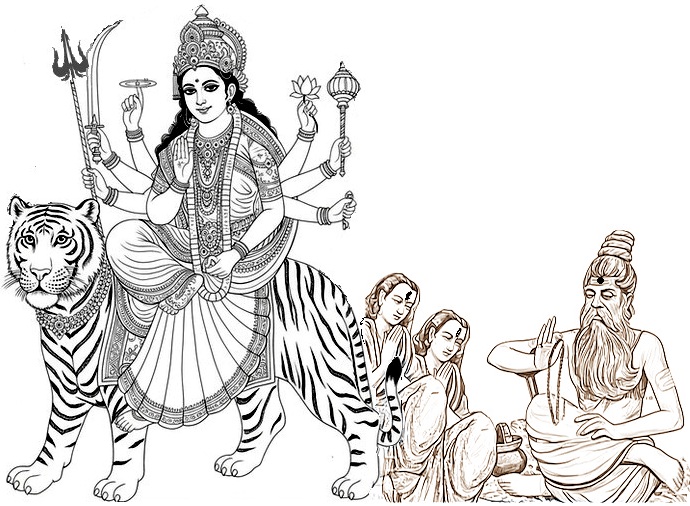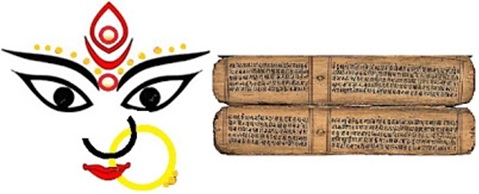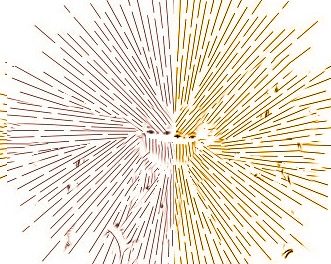
Chandi Saptha Sathi
-Santhipriya-
What is Chandi Saptha Sathi? It is a Hindu religious text describing the glory of Goddess Parameswari also called Goddess Durga who destroyed demonic forces and saved the mankind; the text consists of 700 verses (slokas) in 13 chapters. The text is also known as Durga Sapta Sathi or Devi Mahatmyam. The word Saptha Sathi denotes figure 700, hence, the text is called as Saptha Sathi. Some say that Saptha Sathi refers to seven feminine warriors from celestial (female devathas) forces. The names of those seven celestials are also mired in controversies; while one section of the Sadak mention their names as Nanda, Shakambari, Bhima, Ratatdantika, Durga, Brahmi and Sadakshi, other scholars mention their names as Brahmi, Varahi, Vaishnavi, Chamunda, Maheshwari, Kaumari and Indrani.
Goddess Durga Parameswari is also known by several other names such as Chandi Devi, Chandika Devi, or Chandika Parameswari Devi. Chandi means fierce or angry. In order to alleviate the sufferings of the celestials and to benefit them, the Devi performed penance by standing on one leg over the fine edge of a needle for nine days. In the first three days of Navratri she manifested as Goddess Mahishasuramarthini, the next three days as Goddess Mahalakshmi and the last three days she appeared in the form of Goddess Saraswathi and destroyed the evil and demonic forces from the universe for the welfare of the mankind. The Devi Mahatmyam, considered to be one of the oldest ancient texts glorifies the greatness of Goddess Chandi Devi.
Devi Mahatmyam comprises of 13 chapters and 700 verses (slokas); each verse is thought to have a magical or supernatural effect. The scripture is reportedly compiled by Maharishi Markandeya during the period 400-600 CE and focuses on the glory of Goddess Durga. It portrays her as the supreme power and the ultimate reality. The Chandi homa is performed by chanting those 700 verses (slokas). The Sadviks consider Devi Mahatmyam to be the most scared text similar to Devi Bhagavata Purana and other Devi Upanishads.
The guidance of a a learned pundit or spiritual master is essential for performing pooja rituals and chanting of powerful bija mantras (Hymns) in Devi Mahatmyam since each word in the bija mantras are powerful and wrong chants can potentially cause adverse physical or mental effects as each word in it release powerful energy waves. The initiator (Guru) guides the disciple over proper pronunciation, procedures followed, internal discipline required which includes daily bathing and wearing clean clothes etc before commencing the pooja rituals for recital of Devi Mahathmiyam.
On the other hand, Devi Mahathmiyam if read by anyone with sincere faith, purity, and concentration like reading the Parayan book concluding it with forgiveness prayer, and without involving pooja rituals, especially during Navaratri festive days, even the layman, will receive the blessings of Goddess Chandi Devi. It is also claimed that unless one has the blessings of Goddess Chandi Devi, they will not be able to recite the Parayan.
Recital of Durga Saptashati, also known as the Devi Mahatmyam or Chandi Saptha Sathi will free a person from all obstacles and endow wealth and prosperity; gives good health, fortune, victory, and supreme happiness besides protecting them from the attacks of evil forces, black magic, and negative influences. It is claimed that Goddess Chandi Devi is present in invisible form around you during the recital, forcing evils to run away in fear. Recital of Devi Mahatmyam beget similar benefits similar to the one you beget when Rig, Yajur and Sama Vedas are recited.
The philosophical meaning of the word Durga means easy to access; the word Durga also refers to the one who saves one from meeting catastrophe. In the text Devi Suktham, the Goddess says ‘ Whoever worship me with devotion, I will turn turn them into Rishis or genius’ Undoubtedly the grace of Goddess Durga is necessary to get rid of one’s illusion and delusion in life.
The Goddess further proclaim ‘I am the greatest amongst all other divines and second to none in this cosmic. I am the creator of the universe, and multiplied myself manifold to save mankind in the universe’
The thirteen parts in Chandi Saptha Sathi have been divided as Prathama Charithra (Chapter-1) , Madyama Charithra (Chapter-2,3,4) and Uttama Charithra (Chapters 5 to 13). The book Chandi Sapta Sati has been written highlighting the glory of the Goddess who came to dispel illusion and bestow wisdom. Devi Mahatmiyam, describes how Goddess Durga reveals about her manifestation and dispels the illusion of mankind.
When Parabrahman created three spaces such as earth, heaven and the underworld, he simultaneously created Goddess Durga, incarnate of Goddess Parvathi, also known as Shakti Devi, as the presiding deity for earth. Hence, whenever it became necessary to destroy the demonic forces who caused misery to the mankind, female Goddesses in many forms manifested and destroyed them. They were assisted in the battles by the Yoginis and other female warrior goddesses from time to time. Even when Lord Vishnu incarnated to destroy certain demonic forces, he could attain success only with the extraordinary powers derived from female Goddess Shakti.
The story of a king named Suratha and a merchant named Samadhi who is a Vaisian who were driven out of their Kingdom and home by their own members who plotted against each of them is a significant narrative frame in the Devi Mahatmyam. Lost and beaten by a cruel twist of fate, they reached the forest and wandered in search of a place to stay. Finally, they reached the hermitage of Maharishi Medhas and sought asylum. The atmosphere in the hermitage was totally calm and peaceful. In despair and anguish, they turned to him for solace and for answers to their agony.
They were warmly welcomed by the Maharishi who offered true hospitality after which he inquired about the purpose of their visit to the forest. Immediately the King busted out and fell at his feet of the Maharishi and narrated his ordeal. The King said ‘I was a righteous and noble ruler who governed my kingdom with due justice and care. Righteousness was never forsaken by me either through lust or fear or greed. However, my fortunes took a tragic turn by the betrayal and internal treachery of my own people and lost my throne and was forced to flee. Oh, venerable Maharishi, I do not know what is happening around me. I led a life of purity and treated every one in my state with respect, be they be rich or poor, I showed no disparity; engaged in the act of several good deeds, engaged myself for the welfare of my folks and in the act of charity of many sorts, but only with the treasures I owned. I had cheated none, nor had eyed on others treasures or properties, nor destroyed their pleasures. I was true to the Goddess whom I worshipped and performed the rituals sincerity. My mind is afflicted with sorrow and I fail to understand why fate has been so cruel to me when I had done nothing wrong’.
Parallel to Suratha’s story was that of Samadhi, the merchant who had similar tale to tell. He had been betrayed by his own family members like wife and sons. Driven by greed, they expelled him from his home and seized his wealth, leaving him destitute though he was inordinately affectionate towards them. Their question to the Maharishi was why destiny is so cruel to punish honest persons like them ?
Maharishi heard everything in patience and replied ‘Oh, King, calm down. You claim to have done only good deeds; claim to be honest; never ran behind wealth nor swallowed the treasures of others; think for a moment, were you not proud of your strength and prowess, did you ever attempt to recollect wrong doings of the past? Can entire life of yours, right from childhood till now free from wrong acts? Why are you blind to the follies you committed? Oh, King, think twice before you speak since root cause of all your present problem is the sins that you had intentionally committed. You are trying to hush up your negative acts, may be unintentionally. After you reached the power of glory, you wantonly insulted and ignored the people who shared your pains and pleasures and helped you reach the zenith of power carrying burdens on their shoulders. Outwardly you may have done several good acts with good intention, but your mind was impure, corrupt and dishonest. You did not do duties renouncing attachments. The one who possess such qualities and sinner mind even if they worshiped Devi with elaborate rituals she will not accept the prayers of such dishonest devotees; they will get the grace only commensurate to the good deeds carried by them; they will however, be punished for the remaining sins simultaneously.
Initially you received the grace of Devi when your mind was pure, with full of good thoughts. When you consolidated the power, your arrogance puffed up with pride; you felt the glory was by your own merit and that Goddess Durga was under your influence; you thought Goddess Durga obliged you for your good deeds; soon your mind and thoughts corrupted.
In arrogance you insulted and ignored all those who were your brain and thoughts, stood shoulder to shoulder with you in pain and pleasure, and warmed up your heart. The Goddess may have allowed your illusion to persist temporarily, potentially to teach you a moral lesson, but, eventually causing your downfall at destined time. Remember you enjoyed good times and received the grace of Goddess Durga because of the merits of your ancestors, not because of your own merit.
What is your plight today; you are alone in wilderness; unable to know the reasons for your fall; no peace of mind as you have not realized the gravity of your mistakes; your suffering is due to lack of self-realization, arrogance, and demonic qualities; only devotion and an understanding of your follies will lead you towards liberation.
Your prayer should stem from the heart; it should involve belief in her in totality with unwavering devotion; prayer with a mind free from evil thoughts or negative intentions leads to spiritual connection when the presence of Goddess Durga can be realized. It would be an unwise act of worship with evil thoughts. Believe me, Goddess Durga will not favor someone with a corrupt heart; genuine prayer requires purity and a sincerity free of negative thoughts; on the contrary, you remained in the world of illusion hoping that Goddess Durga will fulfill all your wishes. You need to come out of the illusion and accept the fact that she has created this entire universe, both moving and unmoving including you and she thus knows true feelings in ones’ heart and mind. Realize that the powerful Goddess Durga is watching you; she knows your anxiety; you can not deceive her with false prayers. She will answer your prayers and help you come out of the ordeal and illusion provided your heart is fully open to her. Burn down entire feelings of revenge from your mind. My sincere advice to you is to chant Chandi Saptashati during the period of Navaratri; it will help you regain what has been lost by you.
The King felt as though some one had hit his head with a huge stone; for few moments he stood speechless trying to realize what went wrong on him; instantly he feel at the feet of Maharishi Medhas and sought his guidance in performing the Chandi Saptha Sathi ritual to appease the anger of Goddess Durga. Magnanimous Maharishi began to tell him how to perform the ritual- Chandi Saptha Sathi.
Maharishi Medhas cautioned the King that before commencing recital of Chandi Saptha Sathi, he should proceed cautiously and slowly, pronouncing each word correctly and quietly , chants soft enough audible only to the reciter. Incorrect chanting of the mystic mantras in the Chandi Saptha Sathi will cause harm to those who chant them because the words are imbued with potent spiritual power; the reciter must know the procedures of the recital fairly well. However, the Chandi Homa is performed by some of the pundits in a structured manner with proper pronunciation and swara meaning dimension or frequencies of musical pitch; they are done either for personal benefits at the request of others for different spiritual and psychic purposes.
Before commencing recital of Navakshari mantra, it should be performed sitting in a well cleaned floor; sacred acts such as Asana (certain postures in sitting), Pranayama (breath control), and Sankalpa (resolve/vow) are done followed by recital of Navakshari mantra in the form of Japa. The Navakshari mantra is most powerful mantra of Goddess Durga; the recital overcome external obstacles, destroy planetary adversities and destroy known and unknown enemies from other spheres. This mantra is especially chanted during the period of Navratri.
The Devi Mahatma should not be read like a book without structured swaras or proper pronunciation; it may give mental satisfaction but will not meet the purpose for which it was indented. When read casually the mystic power vibrations will not get activated by each word recited thus offsetting the purpose for which the exercise was undertaken. For those seeking liberation (freed of birth and death), the guidance and diksha from a guru is considered essential as he can only provide proper instruction on pronunciation, rhythm and the correct context for the recitation.
During a divine dialogue on between Lord Shiva and Goddess Parvathi, the greatness of Chandi Saptha Sathi was explained by Lord Shiva thus. ‘The recital alleviates poverty and free the seeker from illusion and delusion which bestow spiritual knowledge and detachment from temporary worldly pleasures. Tripura represents three forms of the Goddess Durga. In the form of Goddess Kali, she destroyed the monster and demonic forces to protect the celestial. She herself manifested as Goddess Lakshmi, associated with wealth and prosperity and as Goddess Saraswathi associated with learning, knowledge and creativity. Her third fieriest form was Chandika. She is the most auspicious Goddess and bestow auspiciousness upon the universe. She is pure form and revered as mother of the universe. Worshiping her provides protection whichever may come from all directions; she bestows happiness and auspiciousness and eliminates suffering’. Lord Shiva went on explaining the greatness of Goddess Durga and benefits one beget by worshiping her. (Even though Lord Shiva and Goddess Parvathi are omnipresent and knower of everything, still to enact certain destined divine play, even the divines lose their divine powers for short periods of time to enact the play. Hence, Lord Shiva and Goddess Parvathi remained stripped of their divine energies for short period of time when Lord Shiva spoke to Goddess Parvathi to explain the greatness of Goddess Durga and Chandi Saptha Sathi – Santhipriya).
Goddess Parameswari put up beautiful smile with a chuckle when Lord Shiva finished his discourse. Irked by her smile when the Lord asked for the reasons of her chuckle, Goddess Parameswari replied casually ‘My Lord, when you narrated the story and greatness of Goddess Durga who was my own manifestation what else will I do except to chuckle?” Embarrassed Lord Shiva came to senses and laughed uncontrollably sharing the joy with Goddess Parvathi. When entire universe watched the joyous moments of Lord Shiva and Goddess Sakthi, the entire mankind in them too rejoiced forgetting all their miseries and sufferings
Maharishi Medhas advised the king to surrender to the Goddess unconditionally and worship her to regain all those lost by him and to find path to salvation, further pointing out that the entire universe rejoiced through Lord Shiva and Goddess Parvathi by the power of Chandi Saptha Sathi. He then gave initiation to the king for reciting Chandi Saptha Sathi, explaining each one of the preliminary steps taken.
Kavach (Shield) Mantra : While reciting the core text of Chandi Saptha Sathi consisting of 700 slokas, it can awaken Shakthi ferociously endangering the raw seeker. The sadhanathviks will have to therefore move forward along with various celestial forces, which may include forms of the warrior Goddess Durga and they may attempt to break the Sadhana for several reasons one being to test the mental fluctuations of the seeker. Therefore, the Kavach mantra is to be chanted after invoking the guardian devathas of ten directions, several devathas who appear in different postures to provide spiritual shield to the sadhanathviks by keeping inimical forces at bay. The sadhanathviks plead for protecting each part of the body from head to foot including breath; seek protection against physical harm, negative spirits, fear and sorrow etc. Therefore, chanting the preliminary mantra Kavach is to seek protection from all obstacles. The Maharishi then proceeded to teach the second part of the procedure.
Argala Mantra:- Chanting of this mantra acts like a bolt which keeps the shield (Kavach mantra) firmly fixed with the sadhanathviks. Argala is the next prayer to Kavach and seek the intervention of Shakthi who act like a sword that destroys any and everything, no matter what they are when they try to intervene to disturb the prayer of the sadhanathvik. Thus, Intervention by Goddess Durga is believed to help the Sadvik overcome various internal disturbances like wavery of mind and attachments to worldly desires etc; only such distractions cause obstruction towards achieving the goals. Hence, unless three mantras like Kavach, Argala followed by Keelaka are chanted, the Devi Mahathmiyam should not be recited; those who do not follow the above will not be able to attain their goal. Maharishi said, ‘listen carefully oh, King, the next mantra to be chanted is called Keelaka’.
Keelaka Mantra:- The next stage after the recital of Kavach and Argala mantras is to recite Keelaga. The Keelaka acts like pin that unlocks the full potential buried within the Durga Saptashati text. The sadhaka’s continuous recital of this mantra, generate vibrations that purify the mind and nervous system so as to allow him have absolute control over wavery mind and other wordily feelings while praying to Goddess Durga. When the sadhaka reaches such state of mind which amounts to total surrender to Goddess Durga, she manifests in his heart and dwells there for few moments as sign of accepting his total surrender (what is stressed as total surrender here is total surrender to Goddess Durga by burning entire inner feelings which obscure the divine). Experienced sadhak knows, similar to how strong lock can not be opened without a key, unless Keelaga is recited the next pathway to reach the abode of Goddess Durga can not be reached, hence, he pins down his energies in one place-recital of Keelaka- instead of letting them remain scattered.
Rathri Suktha mantra :- Suktham means prayer. Though the Ratri Shuktam is a Rig vedic hymn dedicated to Ratri Devi, the personification of the Divine Night, the puranic traditions interprets this hymn to be glorifying Goddess Durga as she dispels ignorance. Rathri means darkness which is associated with ignorance. Ratri Shuktam is the first significant hymn or prayer in Rig Veda which is recited in praise of Goddess Durga for the benefit of mankind and therefore, it is believed that such a most beautifully composed, aesthetically perfect, which provokes deep, quiet thought may not have been composed by humans and therefore, only invisible Vak Devathas may have composed them. The recital of this sloka not only tune up the body’s energy levels of the sadhak but also enhance mental power and revitalize it.
When darkness falls, entire universe temporarily remains motionless thus allowing the weary living beings to rest (Here the night represents the ignorance). However, the Goddess of night called Rathri Devi keeps awakened during the period of night, watching the moments in the universe to carefully protect it. Therefore, in sandhya kala the most powerful and potent Rathri Suktha mantra, consisting of eight words. Similarly, Devi Suktha mantra is chanted in the day time too to please Goddess Usha Devi who is the daughter of Lord Sun, and also manifestation of Goddess Sakthi to bestow wisdom and destroy the ignorance as she is awake during the period of night. The unwritten principle to the sadhaka is recite Rathri Suktha mantra before recital of Chandi Saptha Sathi and thereafter conclude it by reciting Devi Suktha mantra. Both Sukthams are essential for completing the Chandi Saptha Sathi parayan, lest the parayan of Chandi Saptha Sathi will remain incomplete.
Navakshari mantra:- Nava means nine. The sadhaka focuses on nine forms of Goddess Durga by chanting nine syllable mantras called Chandi Gayathri to remove illusion and ignorance from their mind. Recital of Chandi Gayathri mantra twenty times a day, continuously for many days, removes the illusion from the minds of the sadhaka when he reaches the state of bliss by the grace of Goddess Anandi also called as Goddess Chamunda. Goddess Anandi is embodiment of bliss, and show the pathway to the state of brahman. The deities associated with Navakshari mantra are Maha Kali, Maha Lakshmi, and Maha Saraswathi. Navakshari mantra is the main mantra of the Chandi Saptha Sathi and unless it is recited, the Parayan of Chandi Saptha Sathi will remain incomplete and sadhaka will not get the desired benefit for which the parayan was recited.
When Maharishi Medhas paused for a while, the King and the merchant wanted to know from him the brief contents of Chandi Saptha Sathi. Maharishi explained thus, ‘The Chandi Saptha Sathi consists of three stories associated with the three manifestations of Goddess Durga. The first story involves Asuras (demons) named Madhu and Kaitabha, who were twin demons who emerged from Lord Vishnu’s earwax during his cosmic sleep (yoganidra). They stole the Vedas from Lord Brahma, and ran away. When Lord Brahma chased them to retrieve back the Vedas, they attacked him. Unable to stand up to their fight, he prayed to Goddess Yoganithra to wake up Lord Vishnu who was in yogic slumber and who can only help him retrieve the stolen vedas. Yoganithra was manifestation of Goddess Durga. Since Goddess Yoganithra was authority for yogic slumber, accepting Lord Brahma’s request, she came out of the body of Lord Vishnu since Lord Vishnu can not wake up till Goddess Yoganithra stayed over his body. Once woken up, Lord Vishnu chased the asuras, fought fierce battle with them and killed both Madhu and Kaitabha with the help of Goddess Durga who took the form of Goddess Mahamaya who held the power to weave maya called illusion that confuses all beings, including deities. When Goddess Mahamaya caused illusion around the asuras, Lord Vishnu killed them by deceit. Therefore, whenever Goddess exercised the power of illusion and controlled someone’s individual mind and confused them, she was called Goddess Mahamaya.
The second story relates to Goddess Mahishasurmadini. In ancient times, the devatas led by Indira had to frequently fight the demons led by Mahisha. Once emboldened by the special boon got from Lord Brahma, asura Mahishasura became invincible and waged a long war with Lord Indira and other celestial forces, defeated them them and drove them away from their realms. The defeated and powerless Celestial forces under the leadership of Lord Indira ran to Trinities- Lords Brahma, Vishnu, and Shiva, seeking protection. The angered Lords pooled their divine energies together to create a warrior goddess. When their fierce energy rays coalesced together, the feminine Goddess Mahishasuramardini, seated on a majestic lion manifested. Without wasting time, she went and waged war with Mahisha’s demon army forces, destroyed all of them and beheaded the head of the demon thus helping Lord Indira get back his lost Kingdom and celestials return to deva loga.
The third story tells on how the Goddess slayed two asuras called Shumba and Nisumba, who with special boon received from Lord Brahma waged war with Lord Indira and the other celestial forces and drove them away from their heavenly abodes besides usurping their power. The defeated gods went to the Himalayas and prayed to Goddess Parvati seeking her help. Goddess Parvathi immediately released from her divine energy, Goddess Ambika who waged war against those asuric forces and in the fierce duel ensued, Ambika pierced Shumbha’s chest with a spear, ending his life and restoring order to allow the celestial forces return back to their abodes in peace.
Having heard the glory of Goddess Parameswari, the King and the merchant anxiously sought initiation and further briefing on Devi Suktham. The merchant Samadhi, who had been quietly listening to the Maharishi asked ‘Maharishi, you mentioned more than once, the word Devi Suktham. Who is the presiding deity of Devi Suktham? What is the glory of Devi Suktha mantras recited in praise of her?
Maharishi Medhas continued ‘Samadhi, the Devi Suktham mantra is prayer slogan recited daily glorifying the supremacy of the Goddess as the ultimate, all-pervading reality, the source of all creation and consciousness. Several Sukthams are found in Rig Veda which have been compiled by few feminine gender rishis. The Devi Shuktam is a powerful hymn in the Rig Veda which is considered to be the foundational text for the worship of Goddess Parameswari. The Devi Shuktam was reportedly composed by the female sage called Vak devatha, the daughter of Rishi Ambruna. She was also a brahma rishi and one of several female seers mentioned in the Vedas who attained high spiritual realization. Why should she compose hymns that glorify the Goddess? There is specific reason for it.
After the universe was created and divine forces manifested to protect the righteous, annihilate the wicked, and to re-establish the principles of dharma in all the four yugas created, one of the important dictates which Parabrahman mandated was, once a divine manifested for certain reasons, few days thereafter, their attributes, greatness, divine plays, purpose of their incarnation, the manner in which they are to be worshiped, the relevant slokas to appease them etc are to be revealed to the folks in the universe through Maharishis, sages, and celestial forces who appear from time to time; they should also explain the aspects to everyone at appropriate time period, lest the very purpose of creation would remain futile and the mankind born in all the four yugas will remain blind to those facts. The mankind should also know the action-reaction, consequences of karma, the remedies for non compliance of dharma , and the manner in which the deities are to be worshiped. These stories, emphasizing glory and greatness, were spread both through oral traditions and by being recorded on materials like palm leaves, leaving a lasting legacy in various cultures and belief systems. Under these circumstances only Goddess Parameswari decided that the purpose of her incarnation and mode of worship be made known to the universe through her attendant deities Vak devatha.
When the task was entrusted to Vak devatha, she desired to compile them as hymns after personally experiencing greatness of the Devi, hence, the Vak devatha merged with the divine energies of the Devi, gained enlightenment, experienced the greatness of the Goddess sitting within her and finally gained back her true form as Vak Devatha; based on her ever-blissful experience she orally narrated the greatness of the Goddess to Maharishi Veda. Maharishi in the form of hymns. Maharishi Veda Vyasa in turn taught them to his four chief disciples – Paila, Vaisampayana, Jaimini and Sumantu end ensured that those were incorporated in Rig Veda. Veda Vyasa is traditionally credited with organizing the ancient Vedic scriptures into four parts, the main amongst them being Rig Veda. The hymns called sthuthis in Sanskrit contains the proclamation of Goddess Durga.
Goddess Durga proclaim that she was the emperor of divines, embodiment of Rudras, Vasus, Adityas, Visva Devas etc; everyone existed within her and were activated by her power; she ensures that celestial deities like Varuna, Indra, and Agni maintain their honor. She speaks for herself; she stretches the bow of Rudra to fire the arrow to destroy the hater of Brahman; she battles for protecting the mankind and she pervades heaven and earth.
She proclaims that she is the source of the celestial deities and all life, the visible and invisible movements; acts of all beings such as eating, breathing, hearing, and speaking; she is the ultimate goddess, the provider of wealth and the bestower of knowledge; she bestow spiritual wisdom to the seekers. Her source is in the waters, in the inner ocean; she is alongside and in all living creatures; she is near to those who desire to be near to her. She can impart knowledge to anyone dear to her; she can make any one the Brahma rishi who possess highest level of knowledge and wisdom.
Goddess Durga further proclaims that she grants abundant wealth to the possessor of oblation to the one who perform and initiate the Soma Yagya and offer the oblation to Tvasthtra and celestial who are dear to her. Known as Parameswari, she is often associated with the supreme Parabrahman and knower of him; manifests in numerous forms and appearances; she pervades everywhere in earth and heaven since celestials have established many abodes dedicated to her in many places and with the vertex, she touches the sky. Satisfied on hearing the sermon, the Kings and Samadhi asked the Maharishi to further explain the ritual of Parayan of Chandi Saptha Sathi.
The Maharishi said ‘Recital of Kavach , Argala and Keelaga are considered mandatory to be recited before commencing Chandi Saptha Sathi Parayan. The demon King Ravana failed to recite Kavach mantra, hence he was slain by Lord Ram. Asura Arunasura, though got boon from Lord Brahma and Lord Shiva had to meet death by forces of the Goddess as he failed to follow due procedure when he performed Chandi Saptha Sathi Parayan. The sacred mantras were actually taught to him by the Trinity – Argala by Lord Maha Vishnu, Keelaga by Lord Shiva and Kavach by Lord Brahma. Chandi Path is a powerful text dedicated to Goddess Shakti. The procedure to chant the slokas (hymns) from the thirteen chapters of Durga Saptha Sathi have been well laid out.
The first part called Prathama Charithra of Devi Saptha Sathi, explains the world of delusion in whose web the entire fleet of Devas and celestial fell and faced misery. In order to come out of it they prayed Lok Matha or Goddess Kali, and requested her to destroy the delusion and illusion which haunted them. Even Lord Vishnu fell prey to illusion created by Lok Matha. The most important and powerful sloka chanted by Lord Brahma to appease Lok Matha, finds prominence in this chapter besides covering the story of annihilation of Madhukaidapar.
Chapters 2 to 4 is called Madyama Charithra, deals with the manifestation of Goddess Mahishasuramardini also called Goddess Mahalakshmi who emerged from the divine energies of several celestials and annihilation of asura Mahishasura and his army. Besides, this chapter also contains hymns which glorifies the Goddess.
Chapters five to thirteen (5-13) is called Uttama Charithra. In this part under Chapter six slaying of demonic force Tumralosana, the seventh chapter on the slaying of the monster called Chanda-Munda and the eighth Chapter deals with the slaying of asura called Raktabija. The nineth Chapter contains story of the slaying of Asuras Shumbha and Nishumbha. Chanting this part in Parayan ensures that the wishes of the seekers get fulfilled.
The twelfth chapter of Uttama Charithra contains the proclamation of Goddess on the benefits of reciting the Chandi Saptha Sathi. The Goddess proclaimed ‘I shall alleviate the sufferings of those who worship me by chanting the slokas in Chandi Saptha Sathi. Especially if one read it on the days of Ashtami, Chaturdashi and Navami, their sins would get washed away. The moment one finished reading the sacred mantras, their misery would end. I shall permanently reside in those houses where the Parayan of this Chandi Saptha Sathi is done. Their enemies will run away and their clan and descendants will prosper. Their homes will be filled with happiness. Wherever Pooja, Yagya and other ritual takes place , if they also performed Parayan of those sacred mantras, the benefit expected from them will turn multifold. Recital of Chandi Saptha Sathi will give enormous benefits than the charities done such as Cow daan, Anna daan, showing Dhoop Deepa, and Pushpa daan etc’
Maharishi continued ‘After completing the recital of preliminary mantras, followed by the 13 chapters from Chandi Saptha Sathi, the Sadhak should carefully recite slokas from Utharangam, the concluding part which is called Devi Suktham or Vak Amrunia Suktham’.
Some more guidelines for Parayan of Chandi Saptha Sathi. One should always recite the entire hymn in Chandi Saptha Sathi in one go without breaking in the middle. In the event the Parayan had to be stopped midway or required break for some unforeseen reason, then the recitation should be restarted from the beginning of that chapter which was stopped at mid point. The pace of recitation should neither be too fast, not too slow and every word should be pronounced carefully and with devotion.
If for some reason the Parayan can not be concluded in a single day, then it could be recited in seven days in the following manner.
Supposing you begin the Parayan on Sunday, then follow the below schedule:
• Sunday : Chapter-1
• Monday : Chapters-2 and 3
• Tuesday : Chapter- 4
• Wednesday: Chapters-5 to 8
• Thursday : Chapters-9 and 10
• Friday : Chapters-11
• Saturday : Chapters-12 and 13
Each one of the Chapters in the Saptha Sathi is under the governance of a principal deity as mentioned below.
• Chapter -1 Goddess Maha Kali
• Chapter -2 Goddess Maha Lakshmi
• Chapter -3 Goddess Sankari Devi
• Chapter -4 Goddess Jaya Durga
• Chapter -5 Goddess Maha Saraswathi
• Chapter -6 Goddess Padmavathi
• Chapter -7 Goddess Mathangi
• Chapter -8 Goddess Bhavani
• Chapter -9 Goddess Arthambika
• Chapter -10 Goddess Kameswari
• Chapter -11 Goddess Bhuvaneswari
• Chapter -12 Goddess Agni Durga
• Chapter -13 Goddess Tharika Parameswari
CONCLUDED







